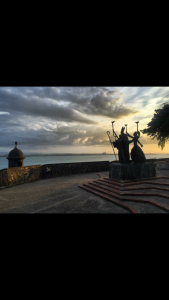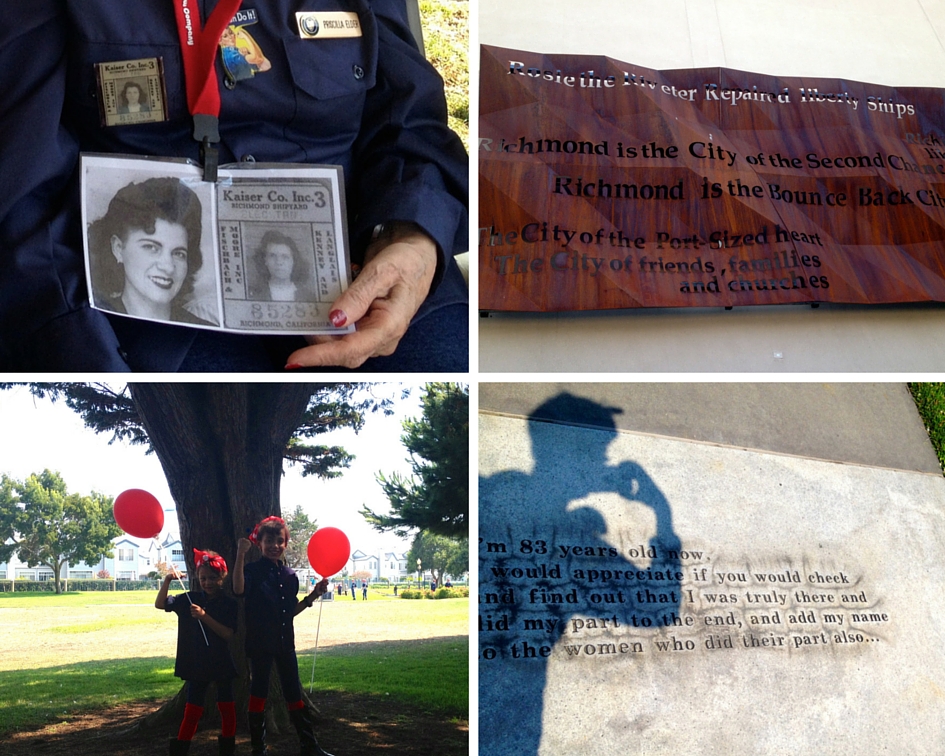“How does one honor the past and also innovate?” a colleague asked a few days ago.
It was the kind of question that reminded me of Rainer Maria Rilke’s invitation in Letters to a Young Poet:
Be patient toward all that is unsolved in your heart and try to love the questions themselves, like locked rooms and like books that are now written in a very foreign tongue.
I recently started working in Richmond, California. Every morning, at different points in my commute, I either pass a large red rectangle that reads: “Richmond: City of Pride and Purpose” or an arrow pointing to the Rosie the Riveter Memorial.
Last Saturday morning, I was at Catahoula, a local coffee roaster, when the owner asked me if I was there to buy a Rosie kit. He waved his hands as he described the Rosie Rally at the Rosie the Riveter Memorial, where women dressed like Rosie were gathering to break the Guinness World record with 1,000 participants. He handed me a pair of thick red socks and a red headscarf with white polka dots.
 The image of Rosie the Riveter dressed in blue overalls with the phrase “We can do it!” above her head was familiar to me.
The image of Rosie the Riveter dressed in blue overalls with the phrase “We can do it!” above her head was familiar to me.
What I didn’t know was that the iconic Rosie, who represents the American women who worked in factories and shipyards during World War II, was inspired by Janet Doyle, a welder working on the Richmond Shipyards, just a few minutes drive from where I work. The Rosie the Riveter Memorial, in fact, sits on the former grounds of Shipyard #2.
Frankly, the mere mention of World War II sends shivers up my spine. However, the invitation to ponder how to honor the past and also innovate sparked my curiosity and interest. The unknown, even when acknowledged as a place of fertility, can also bring up its share of discomfort.
I didn’t know that I would have to walk several blocks in my Rosie attire to locate the bus stop, which had been re-routed due to construction at the Richmond BART station.
I didn’t expect to feel self-conscious at the attention I was getting because of the way I was dressed, standing in an unfamiliar place.
I didn’t know that the bus would be running late on an already infrequent weekend schedule. Even when I was frequently sipping water, I was sweating in my long sleeves and boots.
I wasn’t counting on staring blankly at the steps of the bus that arrived promptly to take passengers to a different destination.
I found a shady spot to stand near the bus stop. Tree leaves shaded the words “Discover Richmond” from apparent view.
Was Richmond playing a game of hide and seek with me? Couldn’t it see that I was there to give us a chance to get acquainted?
Forty-five minutes later, I was ready to turn around and take the BART home. Yet the longing to join all the other Rosies wouldn’t let me quit.
It hit me that I hadn’t introduced myself to Richmond yet, the way I introduced myself to all my new colleagues.
I leaned against the tree bark with my right hand. I whispered:
Hi, I’m Annabelle. I just started working here. My intention is to contribute to your beauty and wellbeing. I have visions, ideas about what that could look like, and I get really excited about it. It may seem like I’m not listening to you. At times, that may be true. Please be patient with me. My intention is to do things with you, not for you or to you. Will you keep on giving me feedback? I get that it may take some time, for us to trust each other. I’ll try to be patient with you too.
I looked up at the intersection, and the red light turned green.
The bus arrived.
These are some of the images from my visit to the Rosie the Riveter Memorial during the Rosie Rally. I think they speak for themselves.
I find it curious that women ancestors of my birth city also did defense work in a port city, albeit in a different context.
This image depicts the statue of La Rogativa. It memorializes the  townswomen who marched through city streets singing, carrying torches and praying for protection. The British Navy, mistaking the procession for the arrival of Spanish reinforcements, retreated.
townswomen who marched through city streets singing, carrying torches and praying for protection. The British Navy, mistaking the procession for the arrival of Spanish reinforcements, retreated.
That city, the city of my birth, now known as San Juan, was initially named by the Spanish Puerto Rico—Rich Port.
The name Richmond, in turn, means “Rich Mountain.”
There is much for me to learn about what supports the inherent richness and wisdom of places to emerge and to participate as stakeholders in conversations on nonviolence.
Places have seen a lot, and they remember. At the same time, looking at places from the perspective that they, like human beings, are also living organisms, I recognize that places too change over time.
I wonder, what does Richmond dream about and hope for?
Perhaps honoring the past does not mean staying in the past. The Rosies were, after all, innovators in their own right.
Perhaps to honor the past is to remember belonging to something larger, to acknowledge the contributions and the connections between each individual to an evolving human narrative.
Perhaps we honor the past to remember that when we innovate, we never do it alone.
And, in case you were wondering, YES WE DID break the Guinness World record!
Photos of the Rosie event courtesy of Annabelle Berrios. Photo of the statue of La Rogativa is credited to Lucia Roman.










Your posts always explore vast territory (spiritually and geographically), and I appreciate your openness to these rich adventures. Yes, we do—love it!
Thank you!
About the photographs, noting a correction- the second one in the “Rosie series” that says “Richmond is the City of Second Chances, Richmond the Bounce Back City,” “The City of the Port Sized Heart, the City of Friends, Families and Churches” was taken just outside the Richmond BART station.
Yes, we do! Yes we are!!
We are not alone: together in this Life.
We are the present of a gifted past, a rich port!
We are at gentle arms with the past and the present. Together we are! Love it-yes we do!